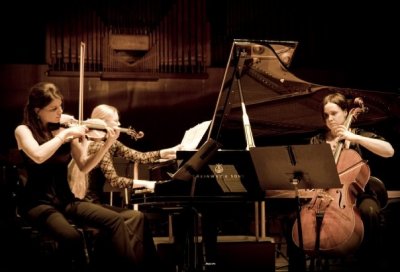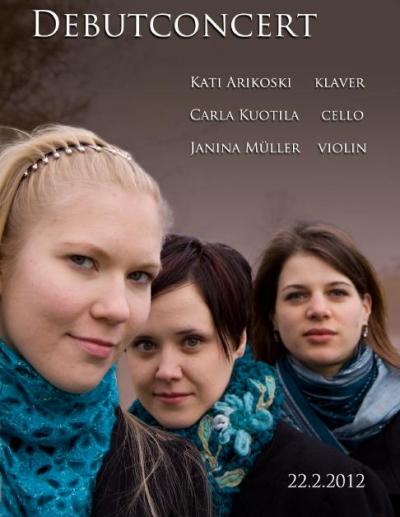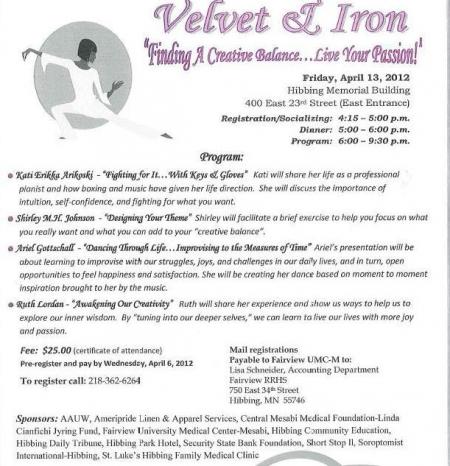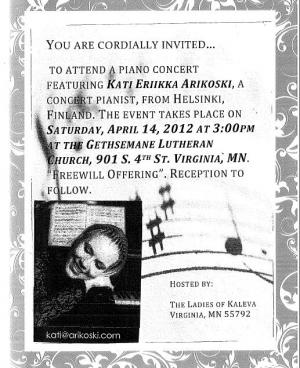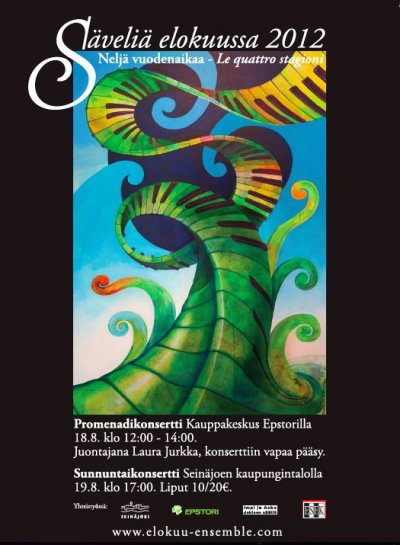Concert Calendar
RSS2012
-
Wed01Feb2012
Trio Gimelia Concert
19:30 Kulturhuset Viften
Trio Gimelia is playing at Kulturhuset Viften:
N. Schmidt: ”Trio for Fiberline” (2004)
I. Strings of Glass: Moderato
II. Amber Heart: Adagio
III. The Incomparable Lightness of Being Strong: AllegroF. Mendelssohn: Klaver trio no. 2 i C-mol, op. 66
I. Allegro energico e con fuoco
II. Andante espressivo
III. Scherzo: Molto allegro quasi presto
IV. Finale: Allegro appassionatoConcert is arranged by Copenhagen Piano School- check out the program
TRIO GIMELIA:
Janina Müller, violin
Carla Kuotila, cello
Kati Arikoski, piano -
Tue21Feb2012
Trio Gimelia- debut concert
19:30 DKDM
Rosenørns Allé 22
Frederiksberg C
Denmark
The debut concerts are one of the lighthouses in the musician’s career. They mark the end of the study programme for the students in the soloist class.
Trio Gimelias debut concert take place on Wednesdays in the Concert Hall of the Academy.
Program:
J. Haydn: Klaver trio no. 25 i C-dur, Hob. XV:27
I. Allegro
II. Andante
III. PrestoF. Mendelssohn: Klaver trio no. 2 i C-mol, op. 66
I. Allegro energico e con fuoco
II. Andante espressivo
III. Scherzo: Molto allegro quasi presto
IV. Finale: Allegro appassionatoPause
N. Schmidt: ”Trio for Fiberline” (2004)
I. Strings of Glass: Moderato
II. Amber Heart: Adagio
III. The Incomparable Lightness of Being Strong: AllegroD. Shostakovich: Klaver trio no. 2 i E-mol, op. 67
I. Andante – Moderato
II. Allegro con brio
III. Largo
IV. Allegretto -
Thu12Apr2012
Lecture in women's conference
18:00 Hibbing Memorial building
400 East 23rd Street
Hibbing, Minnesota
USA
Fighting for it!
With keys and with glovesKati Arikoski’s story begins with a childhood interest in both music and boxing. These activities have given her life direction, leading to her profession as a pianist. While one would think there are only differences between boxing and music, Kati will tell of the similarities of focus, flow, and energy between them. She will explain the importance of, intuition, self-confidence, and fighting for what you want.
In 1994 the “Velvet & iron” Women’s conference was created by three women: Jana Bell, represented the Central Mesabi Medical Foundation, Mary McCauley of the Hibbing Community College and Shirley Johnson of the Fairview Employee HELP System. They wanted women to have the opportunity to attend a local wellness event that would be educational, inspirational, and give them an opportunity to socialize and have fun. Empowering women through knowledge and support continues to be a focus.
Since that time the conference has continued to be annual event and is sponsored by many community organizations. -
Fri13Apr2012
Solo Concert
15:00 Gethsemane Lutheran Church
901 4th Street South Virginia, Minnesota, 55792, USA
South Virginia
USA
Kati Eriikka Arikoski have been invited to play a solo concert at the Gethsemane Lutheran Church in Minnesota by organization Ladies of Kaleva.
Leevi Madetoja: The Pastoral Suite op. 34
1. Morning
2. Caprice
3. Legend
4. WaltzF. Chopin: Mazurka in A minor, op. 17 no.4
L. Sumera: Pardon, Fryderyc!
M. Fagerudd: InstruMental I
Jean Sibelius: Finlandia op.26
Leevi Madetoja’s Pastoral Suite was originally composed as a piano work in 1916. It is a suite with four small songs that come closer in nature to salon music. The first movement “Morning” is to some extent emanating the influence of Norwegian composer Edward Grieg. The second movement is a lively Caprice. The typical caprice is one that is fast, intense, and often virtuosic in nature. The third “Legend” is dominated by the static, melancholy mood typical of Madetoja, and a finally “Waltz” marked at times by unpredictable rhythms.
-
Sat12May2012
Trio Gimelia performs in Anniversary concert
11:00 DKDM
Rosenørns Allé 22
Frederiksberg C
Denmark
Trio Gimelia is playing in Torben Nielsen’s (Projectconsultant at Wonderful Copenhagen) anniversary concert:
J. Haydn: Klaver trio no. 25 i C-dur, Hob. XV:27
I. Allegro
II. Andante
III. PrestoKati Arikoski, piano
Katariina Roth, violin
Carla Kuotila, cello -
Fri08Jun2012
Solo Concert
20:00 Tranum Strandgård-Kunst og kulturcenter
Strandvejen 143 A, Tranum Strand, 9460 Brovst
Brovst
Denmark
Kati Eriikka Arikoski will play solo concert in Tranum Strandgård Kunst og kulturcenter.
Link to culture center’s home page
Leevi Madetoja: The Pastoral Suite op. 34
1. Morning
2. Caprice
3. Legend
4. WaltzM. Fagerudd: InstruMental I
Interval
F. Chopin: Mazurka in A minor, op. 17 no.4
L. Sumera: Pardon, Fryderyc!Jean Sibelius: Finlandia op.26
-
Thu19Jul2012
Trio Gimelia Concert
20:00 Skt. Nicolai Kirke, Rønne
Bornholm
Trio Gimelia will play a concert in Bornholm:
Link to Skt. Nicolai churche’s summer concert calender
J. Haydn: Klaver trio no. 25 i C-dur, Hob. XV:27
I. Allegro
II. Andante
III. PrestoN. Schmidt: ”Trio for Fiberline” (2004)
A. Dvořák Piano Trio No. 4 in E Minor (also called Dumky trio)
I. Lento Maestoso
II. Poco Adagio
III. Andante
IV. Andante Moderato (Quasi Tempo di Marcia)
V. Allegro
VI. Lento MaestosoKati Arikoski, piano
Katariina Roth, violin
Carla Kuotila, cello -
Fri17Aug2012
Melodies in August
12:00 Seinäjoki, Finland
Melodies of August gathers Elokuu-ensemble together in Seinäjoki again 18-19/8.2012.
Promenade concert, hosted by Laura Jurkka.
Performed by
Samuli Peltonen, cello
Mikk Murdvee, violin / viola
Reetta Kataja, violin
Leena Jaakkola, violin
Mathias Hortling, cello
Kati Eriikka Arikoski, piano
Anna-Mari Murdvee, piano -
Fri17Aug2012
Melodies in August- visiting concert
18:00 Koivukoti
Perälänmäentie 111 61270 Luopajärvi
61270 Luopajärvi
August- Ensemble is making a traditional visiting concert to Koivukoti in Jalasjärvi.
-
Sat18Aug2012
Melodies in August
17:00 Seinäjoki, Finland
Melodies of August gathers Elokuu-ensemble together in Seinäjoki again 18-19/8.2012.
Antonio Vivaldi (1678–1741), Vuodenajat – “Le quattro stagioni”
Concerto No. 1 E-duuri, Op. 8, “La primavera” (Kevät)
I Allegro
II Largo
III Allegro PastoraleConcerto No. 2 G–molli Op. 8, “L’estate” (Kesä)
I Allegro non molto
II Adagio e piano – Presto e forte
III PrestoIgor Stravinsky (1882–1971)
Le sacre du printemps (Kevätuhri, sovitus neljälle kädelle)*intermission*
Concerto No. 3 F-duuri Op. 8, “L’autunno” (Syksy)
I Allegro
II Adagio molto
III AllegroConcerto No. 4 F-molli Op. 8, “L’inverno” (Talvi)
I Allegro non molto
II Largo
III AllegroSamuli Peltonen, cello
Mikk Murdvee, violin / viola
Reetta Kataja, violin
Leena Jaakkola, violin
Mathias Hortling, cello
Kati Eriikka Arikoski, piano
Anna-Mari Murdvee, piano
Janne Ahvenainen, viola
Juha Kleemola, double-bass
Lauri Honkavirta, cembalo -
Thu15Nov2012
Piano Duo Concert
19:00 Porvoonseudun Musiikkiopisto
Kaivokatu 37 06100 Porvoo
06100 Porvoo
Finland
Piano duo Anna-Mari Murdvee and Kati Eriikka Arikoski are performing Maurice Ravel and Igos Stravinsky.
This evening in Porvoo we will perform two pieces for piano duet: The Rite of Spring by Igor Stravinsky and Ma Mère l’Oye by Maurice Ravel.
no images were found
Radio YLE Pohjanmaa’s little interview (in finnish) of our piano duo:
Radio Yle Pohjanmaa interviewPROGRAM:
We will start our concert with Ma Mère l’Oye (Mother Goose), which is a musical work by French composer and pianist Maurice Ravel.
Ravel originally wrote this piece as a piano duet for the Godebski children, Mimi and Jean, ages 6 and 7. Ravel dedicated this work for four hands to the children (just as he had dedicated an earlier work, Sonatine to their parents). Here are the movements of this piece:
I. Pavane de la Belle au bois dormant (Pavane of Seeping Beauty)
II. Petit Poucet (Little Tom Thub)
III. Laideronnette, Impératrice des pagodes (Little Ugly Girl, Empress of the Pagodas)
IV. Les entretiens de la Belle et de la Bête (Conversation of Beauty and the Beast)
V. Le jardin féerique (The Fairy Garden)Sleeping Beauty and Little Tom Thumb were based on the tales of Charles Perrault, while Little Ugly Girl, Empress of the Pagodas was inspired by a tale (The Green Serpent) by Perrault’s “rival” Marie-Catherine, Comtesse d’Aulnoy. Beauty and the Beast is based upon the version of Jeanne-Marie Leprince de Beaumont. The origin of The Fairy Garden is not entirely known.
After Ravel comes Igor Stravinsky’s ballet work The Rite of Spring. It was written for the 1913 Paris season of Sergei Diaghilev’s Ballets Russes company, with choreography by Vaslav Nijinsky. He also made a four-hand piano arrangement which became the first published version of The Rite; he and the composer Claude Debussy played the first half of this together, in June 1912.
When the ballet was first performed, at the Théâtre des Champs-Élysées on 29 May 1913, the avant-garde nature of the music and choreography caused a near-riot in the audience. Nevertheless, Stravinsky’s music achieved rapid success as a concert piece, and became recognised as one of the most influential musical works of the 20th century. It is very widely performed in the concert hall, and is frequently revived on the stage.
Part I: L’Adoration de la Terre (Adoration of the Earth)
I Introduction
II Augurs of Spring
III Ritual of Abduction
IV Spring Rounds
V Ritual of the Rival Tribes
VI Procession of the Sage: The Sage
VII Dance of the EarthPart II: La Sacrifice (The Sacrifice)
VIII Introduction
IX Mystic Circles of the Young Girls
X Glorification of the Chosen One
XI Evocation of the Ancestors
XII Ritual Action of the Ancestors
XIII Sacrificial Dance -
Wed05Dec2012
Trio Gimelia Concert
18:30 Finland Ambassade
Copenhagen
Trio Gimelia (Kati Arikoski, Piano, Katariina Roth, violin, Carla Kuotila, Cello) will perform 6.12.2011, Finland’s Independence Day, at the finnish ambassade finnish and danish music at Moltkes Palæ in Copenhagen.
J.Sibelius: Piano Trio in C “Lovisa Trio” (1888)
I Allegro
II Andante
III Allegro con brioJean Sibelius (1865-1957) is well-known for his symphonies, violin concerto and tone poems, but outside of his string quartet “Voces Intimae”, none of his many chamber works has received the attention of the public. Yet many of these works are well worth performing. The Lovisa Trio is one such work.
From 1885 to 1889, he studied music in the Helsinki Music Academy. It was during this period that the Piano Trio in C Major, composed in the summer of 1888, was composed. It has no opus number but has become known as the Lovisa Trio as it was composed at the family country home near the village of Lovisa.
Although Sibelius was only 23 when he composed the trio, it is surprising mature. Up to this point his earlier works were based on classical models, but in the Lovisa trio, he has moved into the territory of full-blooded Romanticism. The opening movement of the trio, Allegro, begins with a buoyant melody full of élan and warmth. The middle movement, Andante, is quiet and tinged with melancholy. The mood is further heightened when the strings enter. The restless main theme of the finale, Allegro con brio, with its striking tonalities and downward-plunging rapid passages leaves a strong impression.
N. Schmidt: ”Trio for Fiberline” (2004)
I. Strings of Glass: Moderato
II. Amber Heart: Adagio
III. The Incomparable Lightness of Being Strong: Allegro“In the process of composing “Trio for Fiberline”, I have reflected a great deal on the possible musical aspects of the two primary components used in the Fiberline Composites product line: fiberglass and polyester. During this process, I found it particularly interesting that the composition of the polyester matrix is almost identical to that of amber. Gradually, it became evident that a piano trio would be an expressive and suitable ensemble for hosting my intentions with this work.
In the Fiberline logo, the number of three is symbolic of the process of creating composite materials. Accordingly, I found it natural to form the trio in three movements.
I felt it was important that the music should speak on its own terms and develop in accordance with its own logic, rather than being merely a sonic, albeit artistic, portrait of glass and plastic that finally unite in happy harmony.
The trio also celebrates Fiberline’s 25th anniversary. Thus, the form of the entire work can be seen as a reflection of Fiberline’s progress during the last 25 years:
the uncertain and near-chaotic mood of creation and innovation in the first movement, the beauty of stable growth in the second movement, and the celebratory mood which the finalé strikes in the conclusion.
– N.S. April 2004″
 Home
Home